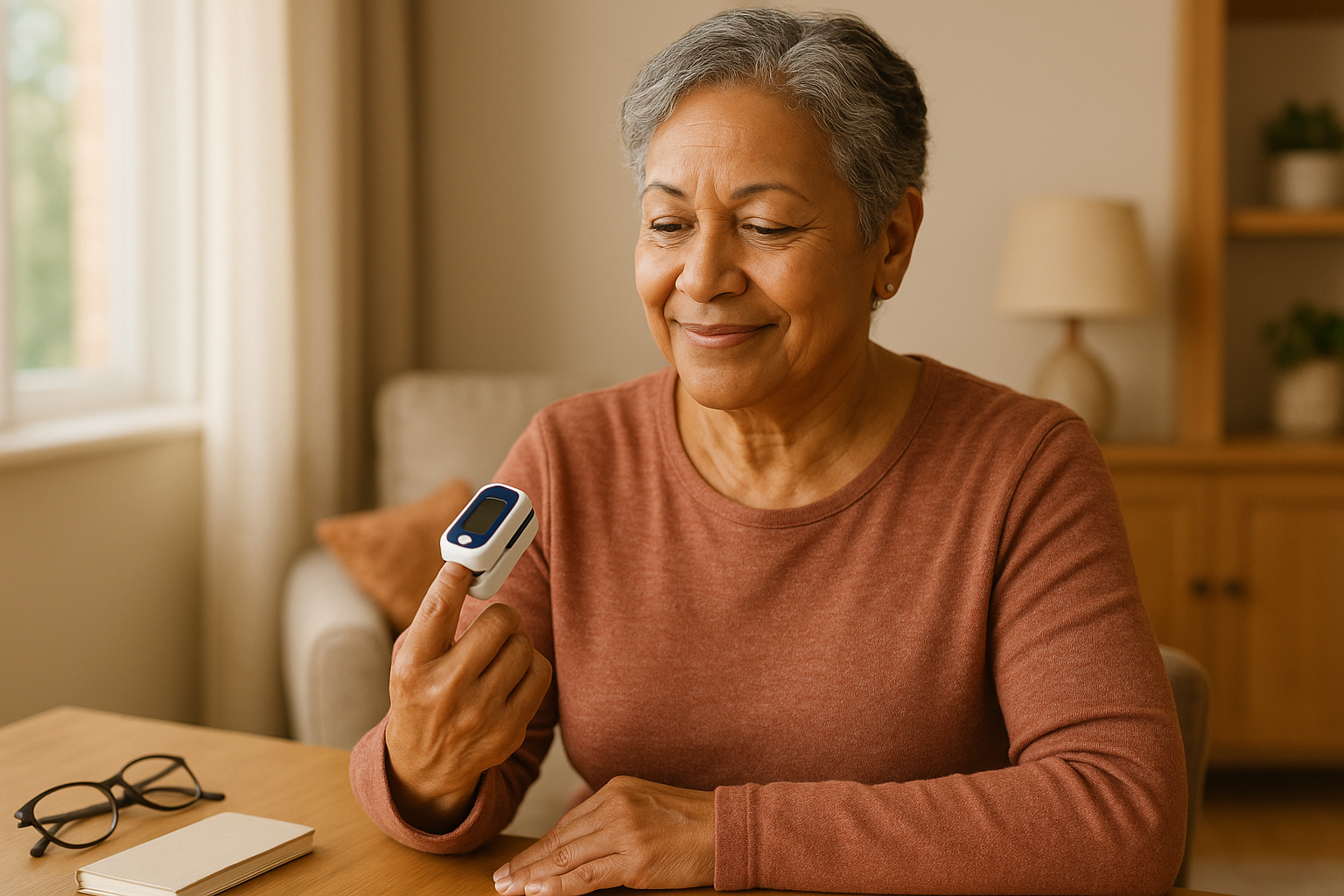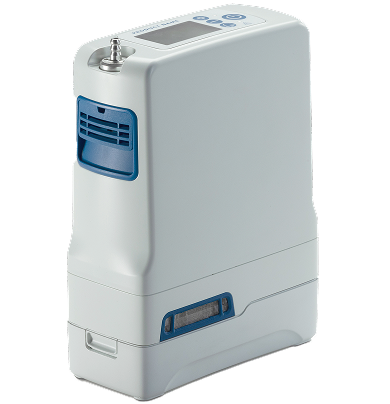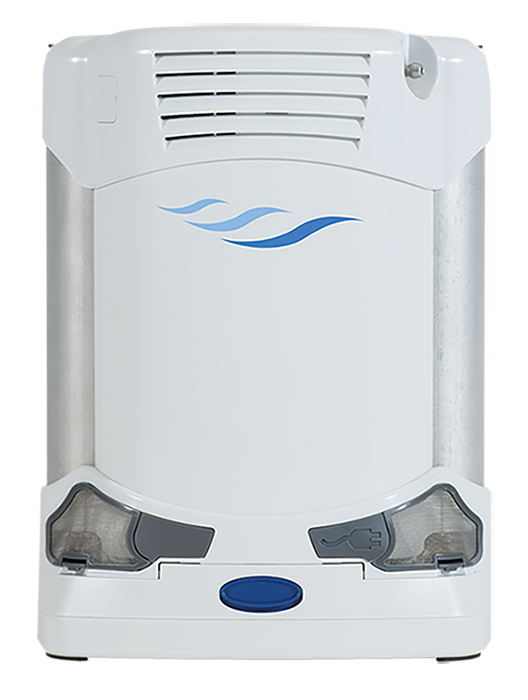Flying with COPD can strain your lungs due to lower cabin oxygen levels, and symptoms like fatigue or breathlessness may appear hours later. Here's what you need to know:
- Monitor oxygen levels immediately after the flight, later in the day, and the next morning using a pulse oximeter.
- Watch for symptoms like unusual tiredness, shortness of breath, or confusion.
- Take action if SpO₂ drops below your safe range (usually 85-90% for COPD patients). Use oxygen therapy or contact your doctor if needed.
- Follow proper pulse oximeter techniques: warm hands, remove nail polish, and stay still for accurate readings.
- Know when to seek help: Severe symptoms like chest pain, low oxygen (below 88%), or difficulty breathing require urgent medical attention.
A pulse oximeter and a COPD action plan are your best tools for staying safe after flying. Monitor closely and act promptly to avoid complications.
Why Flying Can Drop Your Oxygen Levels
How Cabin Pressure Affects Your Oxygen
When you're flying, the cabin of an airplane is pressurized to mimic conditions at higher altitudes, which are quite different from sea level. This reduced cabin pressure translates to a lower amount of available oxygen, something that can have a noticeable impact - especially for individuals with COPD or other respiratory conditions.
What’s more, the effects of this oxygen reduction don’t always disappear the moment you step off the plane. Your body may need time to bounce back from the strain caused by the flight. These changes can linger, showing up later as physical symptoms.
Common Symptoms After Flying with Low Oxygen
The symptoms tied to reduced oxygen levels tend to creep up slowly, making it tricky to connect them directly to flying. You might feel an unusual level of fatigue - more than what you'd typically expect from travel alone - making even simple tasks seem like a challenge. Other signs to watch for include shortness of breath, headaches, dizziness, or a combination of these.
On top of that, your brain might feel the effects too. You could experience confusion or find it harder to concentrate, as reduced oxygen levels can interfere with mental clarity.
Research highlights the seriousness of this issue, with up to 20% of respiratory patients requiring unplanned medical care within a month of flying[1]. Keeping a close eye on your condition after air travel is essential.
When to Check Your Oxygen Levels After Flying
Monitoring Your Oxygen Levels Post-Flight
If you have COPD, keeping track of your oxygen levels after flying is important. While there’s no universal schedule, many people take readings right after deplaning, once they’ve settled in, and later that day or the following morning. These checkpoints can help you gauge how well your body is recovering. It’s a good idea to discuss a monitoring plan with your healthcare provider. If your readings show a drop or your symptoms worsen, you may need to check your levels more often.
Signs You Should Monitor More Closely
Pay extra attention to your oxygen levels if you notice increased shortness of breath, chest tightness, unusual fatigue, or if you’ve been on a long flight or traveled through areas with significant altitude changes. In such cases, frequent monitoring and consulting your doctor can provide the guidance you need.
Studies suggest that up to 20% of respiratory patients may need unexpected medical attention within the first month after flying [1]. This highlights the importance of staying vigilant and working with your healthcare provider to effectively manage your condition.
Your OXYGEN saturation DROPS when flying! (blood SpO2 science test)
How to Get Accurate Pulse Oximeter Readings
Using a pulse oximeter correctly is key to monitoring your oxygen levels after a flight. An inaccurate reading can either cause unnecessary stress or, worse, lead to overlooking a genuine issue. By following the right steps, you can ensure that each reading reflects your actual oxygen levels, helping you make informed decisions about managing your COPD post-flight.
Step-by-Step Pulse Oximeter Instructions
To get the most reliable results, follow these steps carefully:
-
Warm your hands for about 30 seconds before taking a reading. Better blood flow leads to more accurate results.
-
Remove nail polish from the finger you plan to use. If that's not an option, switch to another finger or even your earlobe.
-
Pick the right finger - usually the middle or index finger works best. Insert your finger with the fingernail facing upward, as the sensor needs to detect light passing through the fingertip.
-
Stay still and relaxed for at least five minutes before measuring. Recent movement or activity can skew results, so find a calm, quiet spot to sit.
-
Insert your finger into the device securely but without cutting off blood flow. Wait 10–30 seconds for the reading to stabilize, and avoid removing your finger until the numbers stop fluctuating.
-
Take multiple readings a few minutes apart, especially if the first result seems off. If a reading looks unusual, wait three to five minutes and try again. Keep a record of your results to track any patterns over time.
How to Avoid Common Reading Mistakes
Even small errors can throw off your pulse oximeter readings. Here’s how to avoid the most common pitfalls:
-
Stay as still as possible. Movement, even minor fidgeting, can disrupt the device's ability to provide an accurate reading.
-
Block out bright light. Direct sunlight, fluorescent lights, or bright LEDs can interfere with the sensor. If you're in a well-lit area, use your free hand to shield the device from excess light.
-
Don’t squeeze the device. Tight pressure can restrict blood flow, affecting the reading. If the device struggles to detect a signal, try another finger or warm your hands more thoroughly.
-
Check the battery. A low battery can lead to erratic readings or slow performance. If your results seem inconsistent, replacing the batteries is a simple fix.
-
Wait after using supplemental oxygen. Allow at least 15 minutes before measuring to get a clearer sense of how your body is handling room air.
-
Consider underlying conditions. Factors like poor circulation or anemia can impact accuracy. If you suspect this might apply to you, consult your doctor for tailored advice or additional techniques to ensure reliable readings.
sbb-itb-3e96dba
What Your SpO₂ Numbers Mean and What to Do
Your pulse oximeter is an essential tool for managing COPD, especially after flying. It measures the percentage of oxygen-saturated hemoglobin in your blood, giving you a snapshot of your oxygen levels.
Understanding Your SpO₂ Levels
For most healthy people, oxygen saturation typically stays above 90% even at cabin altitude (approximately 8,000 feet) [2]. At sea level, it’s usually in the mid to high 90s. However, if you have COPD, your baseline may naturally be lower. Experts recommend keeping your SpO₂ at 85% or higher during flights [2]. Knowing your personal target is critical - small fluctuations in your levels can have a big impact.
These readings help guide your next steps and ensure you're staying within a safe range.
What to Do Based on Your Readings
Here’s how to respond to your pulse oximeter readings:
- If your reading is at or above your target (85% or higher): Continue monitoring as usual. No changes are needed.
- If your reading is below your target:
- Use any prescribed techniques, adjust your supplemental oxygen if instructed, and check again after resting.
- If your levels stay low or you notice symptoms worsening, contact your healthcare provider right away.
- If your symptoms are severe or your oxygen saturation drops dangerously low: Call 911 or seek emergency medical help immediately.
Your SpO₂ numbers are a vital part of managing your health. Always act promptly if they fall outside your safe range.
When to Get Medical Help After Flying
Flying with COPD can sometimes lead to complications that require urgent medical attention. Recognizing when to act can make all the difference between handling a manageable issue and dealing with a serious emergency. Keep a close eye on your symptoms, and if your SpO₂ levels fall outside your safe range, take immediate action.
Serious Symptoms That Need Medical Care
Seek emergency help right away - call 911 or head to the ER - if you notice any of the following after your flight:
-
Dangerously low oxygen levels
If your SpO₂ stays below 88% while you're at rest for several minutes, this is a medical emergency [4][5]. -
Severe breathing difficulties
Pay attention to extreme shortness of breath that worsens with little activity, trouble completing full sentences, or a cough that interferes with breathing [3][7][8]. -
Physical warning signs
Symptoms like chest pain, tightness, bluish lips or face (cyanosis), confusion, or trouble staying awake signal that your body isn’t getting enough oxygen [4][5][7][8]. -
Heart-related signs
Watch for a rapid or irregular heartbeat, lingering headaches, dizziness, fainting, or new swelling in your legs. These could point to dangerously low oxygen levels or potential blood clots [4][5].
If you have severe COPD, use supplemental oxygen, have a history of heart disease, or experienced complications during your flight, be especially cautious. Long flights, recent respiratory infections, or skipping prescribed oxygen can also increase your risk [3][5][6].
Should symptoms arise, stop any activity, sit upright, use your rescue inhaler or oxygen, and get medical help immediately. Don’t delay if symptoms persist [4][5].
Why You Need a COPD Action Plan
Your COPD action plan is a critical tool for managing emergencies. Developed with your healthcare provider before traveling, it gives you step-by-step instructions to follow when problems occur. This plan eliminates uncertainty and can stop small issues from escalating into serious health crises [5][6].
A good action plan should outline:
- Specific SpO₂ levels that signal when to act
- Guidance on adjusting medications
- Instructions for using supplemental oxygen
- Clear criteria for seeking emergency care [5][6]
It should also include your emergency contacts, a list of your medications, and any specific instructions from your doctor.
Acting quickly according to your plan can prevent serious outcomes. For instance, a traveler with COPD who experienced a SpO₂ drop to 86%, along with dizziness, followed their plan by using a rescue inhaler and contacting their doctor. This quick response ensured they received prompt care and avoided complications [5].
Experts recommend monitoring your SpO₂ regularly for at least 24 hours after flying, especially if you notice any symptoms [5][6]. Always pack your pulse oximeter, extra batteries, and a copy of your action plan when you travel.
If you don’t have your pulse oximeter and experience new or worsening symptoms like severe breathlessness, chest pain, or confusion after your flight, don’t wait. Get medical attention immediately [4][5]. Even without SpO₂ readings, these symptoms can indicate a serious issue.
Conclusion: Monitor Your Oxygen to Stay Safe
Flying with COPD can be manageable if you keep a close eye on your oxygen levels. The key is having a monitoring plan that covers not just the flight itself but also the critical 24 hours after landing. A pulse oximeter becomes an essential travel companion - not just during the flight but especially in the hours following your arrival.
Changes in cabin pressure can affect your oxygen levels even after you’ve landed. Your body needs time to adjust, meaning symptoms might not show up right away. By checking your SpO₂ at key moments - like at the gate, before going to bed, and the next morning - you can catch potential problems early and act before they escalate.
To get accurate readings, proper technique is crucial. Make sure your hands are warm, your fingers are clean, and you remain still while measuring. If your oxygen levels dip below your normal range - especially below 90% - it’s time to take action without delay.
Pair your monitoring routine with a solid COPD action plan. Think of your action plan as your safety guide - it eliminates uncertainty in emergencies and provides clear steps to follow if your oxygen levels drop or your symptoms worsen. Whether it’s using a rescue inhaler, adjusting your oxygen flow, or heading to the nearest emergency room, having a plan ensures you’re ready for any situation.
Finally, listen to your body. If you experience severe breathlessness, chest pain, confusion, or if your SpO₂ stays below 88%, don’t hesitate to get medical help. These are signs that need immediate attention, not a wait-and-see approach. Prioritizing your health is the best way to ensure a safe journey.
FAQs
If you're planning to fly with COPD, it's essential to take some precautions to keep your oxygen levels stable and your journey as smooth as possible. Start by talking to your healthcare provider - they can assess your oxygen needs and assist in arranging supplemental oxygen if required.
Be sure to pack a portable pulse oximeter to monitor your oxygen levels during the flight, and don't forget extra batteries. It's also wise to carry a letter from your doctor that outlines your condition and any specific medical needs. Before your trip, check with the airline about their rules for oxygen use to avoid any last-minute complications.
By preparing ahead, you can make your flight safer and more comfortable.
To keep track of your oxygen levels after flying with COPD, a portable pulse oximeter can be a lifesaver. Check your SpO₂ at key moments: while still at the gate, once you’ve settled into your hotel, before going to bed, and again the next morning. Make sure your device is functioning properly - carry extra batteries and stick to the manufacturer’s instructions for accurate readings, like keeping your hand steady and warm during use.
If your oxygen levels fall below 92%, don’t hesitate to reach out to your healthcare provider for advice. Staying on top of your oxygen levels can help you catch any issues early and ensure a smoother recovery after your trip.
Creating an Effective COPD Action Plan
When managing COPD, having a clear action plan is essential. Your plan should help you keep track of your symptoms, recognize warning signs of a flare-up, and know exactly what steps to take. A helpful approach is to use symptom zones:
- Green Zone: This means your symptoms are under control, and you’re feeling stable.
- Yellow Zone: This signals caution - your symptoms may be worsening, and adjustments to your treatment might be needed.
- Red Zone: This is an emergency. Seek immediate medical attention if your symptoms become severe or don’t improve.
Make sure your plan includes detailed instructions for each zone, such as when to adjust your medications, contact your doctor, or head to the emergency room.
To stay prepared, consider carrying a portable pulse oximeter (with extra batteries) and your prescribed medications while traveling. This allows you to keep an eye on your oxygen levels and act quickly if there’s a sudden change, especially after a flight.





